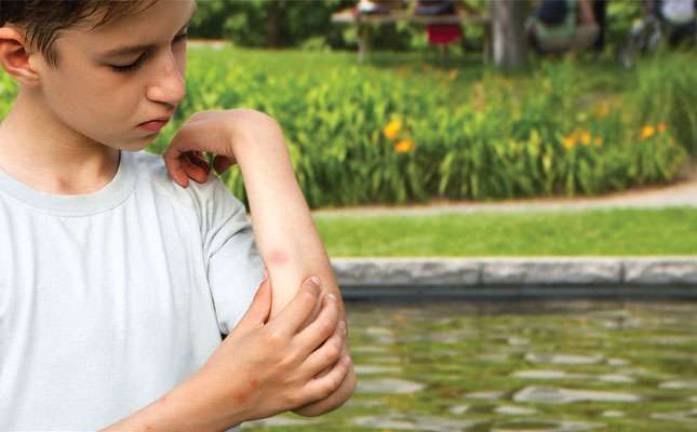What to do when you're stung

Summertime means more time outdoors, where you may suffer many types of stings — mosquito bites, wasp bites, bee stings, spider bites, tick bites, or fire ant bites. Wile most consider insect bites a minor annoyance, they are life-threatening to the two million Americans allergic to their venom. In fact, there are at least 50 deaths each year in the U.S. because of allergic reactions from insect stings. And people who have suffered an allergic reaction have a 60 percent chance of a similar or worse reaction if stung again.
So how should you react to an insect sting?
Is it a bite, infection, or MRSA?It’s scary when your skin gets suddenly swollen, sore, and red. Many people naturally assume the source of is a spider bite, an ant bite, or some sort of insect sting, especially in the summer when they’ve been spending more time outdoors. Although the redness and swelling may be a localized allergic reaction to the insect bite, it could be a skin infection contracted after the bite, such as MRSA (methicillin-resistant staphylococcus aureus).
A normal allergic reaction causes swelling, redness, and minor pain all around the site of the insect sting or bite. A localized allergic reaction results in swelling that goes far beyond the site and may look alarming, but is really no more serious than a normal reaction.
A skin infection can develop after a bite or sting, especially if the area is frequently scratched, because that chafing damages the skin and allows bacteria to get in. The infection first appears as redness and soreness around the bite, but that swelling can spread within days and become serious if not treated.
MRSA is a strain of staph bacteria that can cause a wide range of skin infections. MRSA first appears as a little bump that looks a lot like an ant bite or pimple, so victims often see a doctor thinking that it’s a reaction to some type of insect sting or bite. However, it may actually be a skin infection that could be highly contagious and can only be diagnosed by a medical provider, usually with a wound culture.
Directions for diagnosisOnce you’ve been stung, pay attention to the bite’s appearance and the way you are feeling. If you’re sure that you’re not allergic and exhibit only a normal or localized reaction, then you can treat the problem on your own with topical medications such as Benadryl without seeking further medical attention.
But if you know you are allergic to insect stings, start showing a worsening allergic reaction, or if you think you may have an infection — especially MRSA — you need to seek immediate medical attentions.
Tips for treatmentThere are many simple types of self-treatment for basic normal and localized reactions. To soothe swelling, apply an ice pack or cold compress to the area. To reduce itching and hives, take an over-the-counter oral antihistamine such as Benadryl. To relieve pain, take a non-steroidal anti-inflammatory drug (NSAID) like ibuprofen. For minor skin infections, you can use an over-the-counter topical antibiotic. Pregnant women should always consult their doctors before taking any over-the-counter medication.
If you’re stung by a bee but are not allergic, you can treat it yourself. Gently remove the stinger and sac of venom that’s left in the skin within 30 seconds to avoid overexposure to the venom. Be careful not to pull on the stinger or squeeze the sac since this will release more venom into your skin. Finally, wash the area with soap and water and apply an antiseptic to prevent infection.
If the bite, sting, or wound looks like it’s infected, this may be a sign of a skin infection or MRSA. This is when you need to seek immediate medical attention.
Many people who have experienced prior severe allergic reactions wisely keep an epinephrine auto-injector on hand so they can treat themselves if they suffer a sting. You can ask your physician for a prescription. Yet since one dose may not reverse a reaction, it’s best to seek medical attention after a self-injection to ensure that the condition is under control. Be aware that life-threatening allergic reactions could require steroids, intravenous fluids, oxygen, and other medical treatments to stabilize the situation.
Reduce your risk Learn to spot and stay away from insect nests. Honeybees nest in beehives. Yellow jackets nest in dirt mounds or old logs on the ground. Hornets and wasps nest in trees, bushes, and on buildings. And fire ants nest in sandy earthen mounds that are usually more visible after rainfalls.
Wear shoes and socks whenever you’re outdoors.
Protect yourself from ticks and other insects that are common in wooded areas by wearing insect repellant and covered clothing, such as long-sleeved shirts, long pants, socks, and shoes.
To reduce your risk of MRSA, maintain excellent hygiene and always cover any skin breaks or wounds with an antiseptic cream and bandage to avoid exposure to the bacteria.
Avoid wearing lotions, perfumes, scented hygiene products, and brightly colored clothing because they tend to attract insects.
Always have someone nearby during outdoor activities if you have severe allergies to help you in case you have a reaction.
Safeguard your home by spraying insect repellent in bedrooms, on plants, in garbage cans, and any areas around your house prone to insects.
If you have severe allergies, you should always wear a medical-alert bracelet and keep an epinephrine self-administration kit within reach to stop severe Source: MD Now: MDNow.com